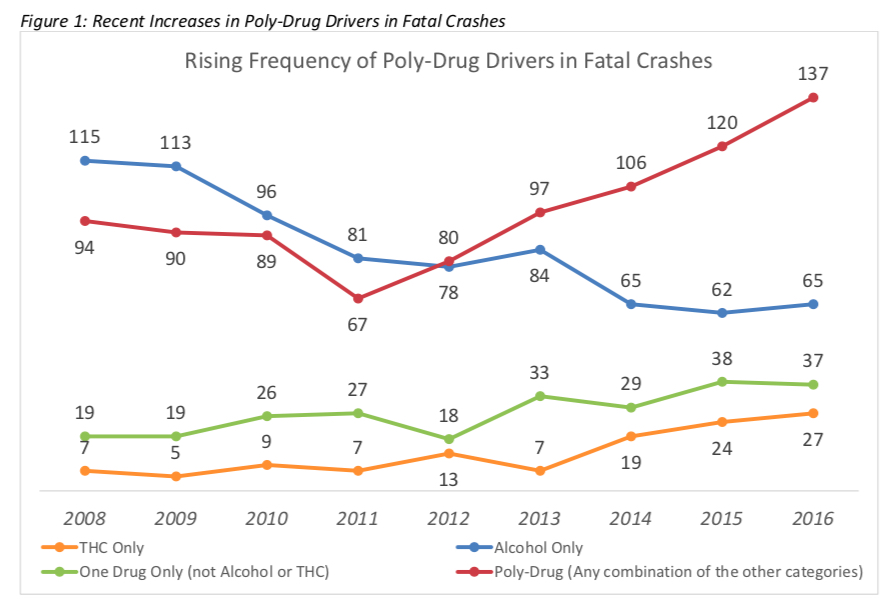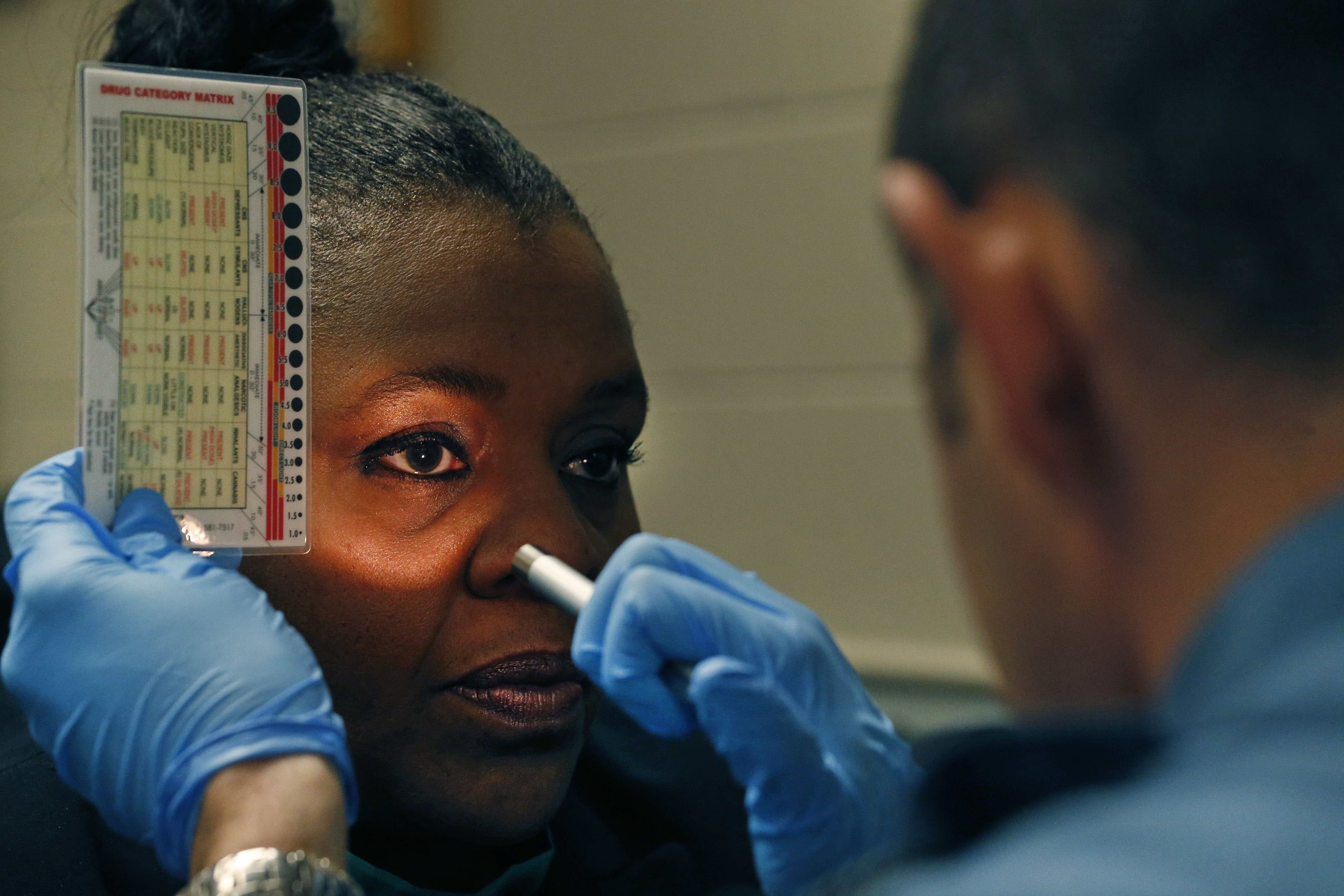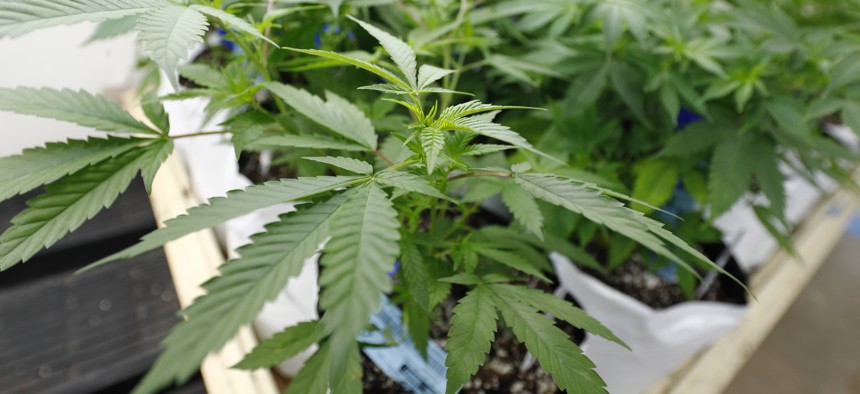Connecting state and local government leaders
With recreational marijuana now permitted some states, questions remain over the best way to detect high drivers.
As legalized marijuana becomes more common in the U.S., the number of drivers testing positive for it has been on the rise in recent years, with some research even showing pot eclipsing alcohol as the most commonly detected intoxicant in people behind the wheel.
But this in itself does not mean there is a wave of stoned driving hitting the nation. That’s because people process marijuana differently than beer, wine and liquor, and its presence in a driver’s blood or saliva doesn’t automatically indicate that the person is impaired.
And while there are decades of research demonstrating how increases in blood alcohol levels correspond to a person’s ability to drive safely, the same is not true for the main component of marijuana that causes a person to feel high—delta-9-tetrahydrocannabinol, or THC.
For law enforcement in states with legal pot sales there have been new efforts focused on helping officers identify drivers who may be impaired from marijuana.
But uncertainty over how to best determine whether a driver is too high to be safe has left some advocates and experts casting doubt on traffic safety laws that depend on fixed thresholds for the level of THC a driver has in their body. Instead, they advocate for police to adopt other methods to figure out if the person is unfit to drive.
“Unfortunately when we look at traffic safety with regard to marijuana, and other drugs, through this lens of alcohol, we become fixated on detection tests,” said Paul Armentano, deputy director for the pro-cannabis group, National Organization for the Reform of Marijuana Laws, or NORML.
“We cannot correlate the detection of THC, whether it’s in blood, or whether it's in breath, or whether it's in oral fluid saliva, with impaired performance,” he added. “Detecting it doesn't give us any information with regard to whether the person is impaired.”
Policy Questions in Era of Legalization
Studies from the 1970s through the 2000s have found pot can affect a person’s ability to drive, slowing reaction times, and causing problems with tracking lanes, focusing and gauging risk.
But other past research backs up what Armentano is getting at: peak impairment from marijuana doesn’t have a clear-cut, linear relationship with a person’s THC level.
When a person smokes marijuana, THC levels often hit an apex about 15 minutes afterwards, while impairment peaks after about 90 minutes, studies have shown. Whereas with drinking, driving performance generally degrades as the level of alcohol in a person’s bloodstream rises.
Meanwhile, chemicals from marijuana can stick around in a person’s body well after they’re no longer high. A frequent medical cannabis user might consistently have detectable levels of THC in their blood without exhibiting any deterioration in their driving skills.
Questions about how to approach policies surrounding cannabis-impaired driving have garnered greater attention in the past six years or so as nine states have legalized recreational marijuana for adults.
Voters in Michigan and North Dakota will decide whether to do so this Election Day. (Update: Since publication of this story, Michigan voters approved legalization, while North Dakota voters rejected it.)
In Colorado, Washington state and California, law enforcement and traffic safety officials described to Route Fifty last week where things stand with their programs for determining if drivers are under the influence of pot, and some of the trends they are seeing.
Washington, for example, is training police officers so that they are certified to draw blood samples from suspected impaired drivers, as opposed to taking the driver to a medical facility.
And a growing problem in the state has been a steep rise in the number of fatal crashes involving drivers who are under the influence of marijuana and alcohol or another drug.
Legalized recreational pot is new territory for U.S. states. But many issues in play when it comes to road safety are not, says Glenn Davis, highway safety manager for the Colorado Department of Transportation, who worked previously as a police officer for about two decades. “People have been driving high since there was probably stagecoaches,” he said. “It's always been a challenge.”
Data Still Coming Into Focus
Some oft-cited statistics on cannabis and driving safety come from a National Highway Traffic Safety Administration study conducted in 2013 and 2014 that found 12.7 percent of nighttime drivers tested positive for THC, up from 8.7 percent in 2007. In contrast, the share of drivers on weekend nights that tested positive for any alcohol has declined from 36 percent in 1973, to 8.3 percent in the 2013-14 results.
In 2014, Colorado became the first state to begin legal recreational marijuana sales in the U.S.
The state’s Department of Public Safety issued a report in July that examines 17,824 DUI case filings there during 2016 that had toxicology results. Among those, 13,620 of the drivers had blood alcohol concentrations at or above the 0.08 legal limit.
Screening for marijuana was conducted in 3,946 of the cases. Of those, 2,885 tests, or about 73 percent, came back positive for THC. Only about half, or 1,369, had THC levels above 5 nanograms per milliliter of blood, a key legal threshold in the state similar to a blood alcohol level.
Last year, there were 35 impaired driving deaths linked to cannabis in Colorado and in 2016 there were 52, according to Davis. He noted that establishing a framework for recording data on traffic safety and marijuana was one of the challenges in the wake of legalization.
Before then, he said, “nobody really kept data on it because it wasn't hot.” But that’s changed.
“We've got like two solid years of data and I think we're going to probably need five or six before we can really analyze where we're at,” Davis said. Some advice he has for states considering legalization: “Start getting your data ahead of time, so you have a baseline.”
For Mark Medalen, impaired driving program manager for the Washington Traffic Safety Commission, the state’s rise in fatal wrecks involving multiple substances is a troubling statistic.
The number of drivers in those crashes testing positive for more than one drug, or drugs and alcohol, climbed steadily from 67 in 2011 to 137 in 2016, state statistics published in April show.
“We know that there's an increase in the number of drivers on our roads that have consumed alcohol and marijuana,” he added, as he discussed incidents where drivers had multiple intoxicants in their systems. “We're really paying attention to that.”
Davis said Colorado is experiencing a similar trend, with a rise in crashes involving more than one substance.
The number of drivers in fatal crashes in Washington who tested positive for THC alone increased from seven in 2013 to 27 in 2016. Recreational sales began there in July of 2014.

University of Oregon researchers this year released a working paper that used statistical modeling to compare marijuana and alcohol traffic fatalities in Colorado and Washington, with a theoretical “synthetic control” scenario where marijuana was not legalized in those states.
They note that deadly marijuana-related crashes increased significantly in Washington and Colorado since 2012, but their findings suggest that these upward trends may have occurred even if recreational pot sales remained illegal.
‘Beyond Just The Blood’
When states set a legal limit for an intoxicating substance in drivers, it’s known as a “per se” law.
Across the U.S., five states have per se standards for pot, according to the National Conference of State Legislatures. These states include Washington, as well as Nevada, where legal recreational sales began last year. Other states with legalized recreational marijuana, such as Alaska, California and Oregon, don’t use that standard in their laws.
Washington’s per se limit is 5 nanograms per milliliter of blood. In Nevada the threshold is 2 nanograms. Colorado has a law in place that says it’s permissible to assume a driver is under the influence of pot if the THC in their blood exceeds the 5 nanogram threshold.
"We've seen a huge increase in blood draws in the last five years,” said Medalen, the Washington Traffic Safety Commission official. “Definitely, I think, there's a direct correlation around the time recreational marijuana was legalized.”
Medalen said his office has issued grants for a pilot project, where police agencies are training officers to become state-certified phlebotomists, who can draw blood, cutting down on the need to take DUI suspects to emergency rooms, or other medical facilities.
But Medalen points out that even with the state’s per se standard, “It goes beyond just the blood ... Blood can't testify in court.” Officer experience comes into play when conducting field sobriety tests, or calling in colleagues trained to detect drug impairment.
Davis, in Colorado, says his state gets pitches from vendors who are offering devices to detect driver THC levels. But putting them into use would require changes to state law, and he offered the view that the state may want to proceed cautiously in this area.
"I was a pretty skilled DUI guy. I didn't need a device, because I could tell by their mannerisms,” he said, recalling his time as a police officer. “I just don't want people to get to a point where they're making an arrest based on a device,” he added. “Presence in itself is not an impairment.”
‘Totality of the Evidence’
Sgt. Oscar Chavez supervises part of the California Highway Patrol’s impaired driving section. Legal retail sales for recreational pot began on Jan. 1 of this year in the state.
Chavez says one of the changes the agency made after legalization went into effect was to mandate that every officer and sergeant complete a 16-hour training program known as Advanced Roadside Impaired Driving Enforcement, or ARIDE, which focuses on teaching officers how to identify and describe the signs of drug impairment.
There’s also a higher level course beyond ARIDE that’s known as Drug Recognition Evaluator, or DRE, training. The process a DRE officer conducts to determine if a driver is impaired by drugs involves steps like observing the person’s pupil size in different lighting conditions, checking blood pressure, and taking their pulse in multiple intervals.

In California, after a DRE officer renders an opinion that a person is under the influence of a drug, that person would have to submit to providing a blood sample, Chavez explained.
If a person is charged with a DUI, the evidence presented in court could include anything from what the officer who first encountered them on the roadway saw, through a standard field sobriety test, any ARIDE observations, the DRE exam and the results of the blood test.
“When it comes to detecting impaired driving nothing has really changed,” said Chavez. “We still train our officers to pretty much take the totality of the evidence.”
Crash Risks
NHTSA conducted one of its other notable studies concerning marijuana and driving from 2010 to 2012 in Virginia Beach. The data included blood samples and saliva measurements from more than 3,000 drivers involved in crashes, and 6,000 who were not in wrecks.
THC was detected in 7.6 percent of the drivers involved in crashes, and 6.1 percent of those who were not.
These initial findings showed the odds of crashing were about 25 percent higher for drivers testing positive for THC. But, when the results were adjusted for other risk factors, like age and gender (for instance, young males tend to get into more wrecks than others), the higher crash risks linked to THC disappeared.
Researchers writing in a recent article in the Journal of Drug Policy Analysis suggest that the maximum risk from cannabis alone, in terms of affecting a person’s driving, is more like talking on cell phone or being drowsy, than driving with an illegal blood alcohol level.
They float the idea that “stoned driving alone (not involving alcohol or other drugs)” should be treated as a traffic infraction, not a crime.
“Even if the testing situation were better-resolved than it currently is,” they wrote, “penalizing driving under the influence of cannabis (alone) criminally with arrest and possibly incarceration is disproportionate to how we treat driving under comparably severe impairments.”
‘Better Tools’
NORML’s Armentano offers ideas to improve the approach to determining if a driver is high and is emphatic that relying on per se THC laws is a mistake.
He’d like to see basic field sobriety tests updated to include validated measures that have been shown to indicate that a driver is specifically under the influence of pot, such as testing how well a person can estimate the passage of 30 seconds of time.
Another policy he supports is an “open-container-like” law for cannabis. People busted driving with an open beer are considered to have broken the law, why not make the same true for marijuana?
"If our concern, rightly, is on better detection of impaired drivers, then our focus needs not to be on the detection of compounds that may or may not be related to impairment,” he said. “Our focus needs to be on providing law enforcement with better tools to actually measure drivers’ performance.”
Bill Lucia is a Senior Reporter for Government Executive's Route Fifty and is based in Washington, D.C.

NEXT STORY: Getting Out the Vote From the County Jail




